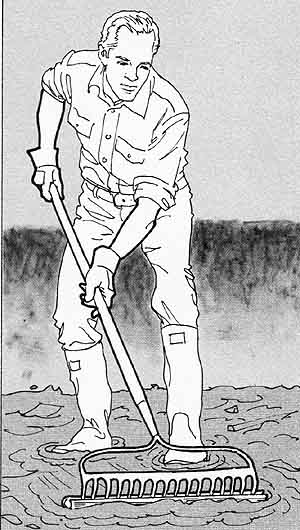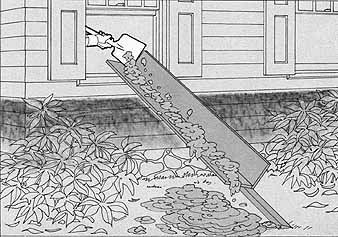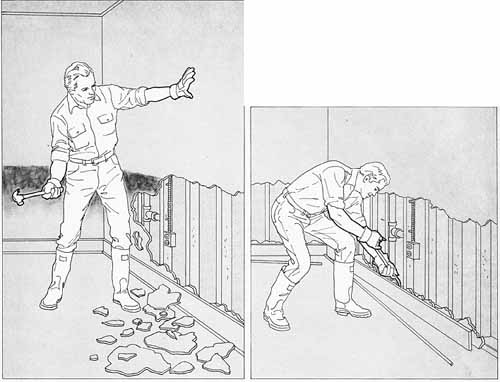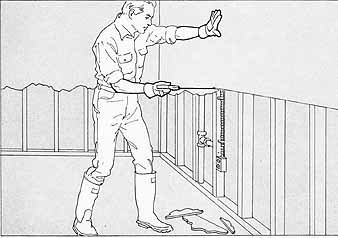There is not much you can do to keep a flood out of your house when a river en gulfs it. If you live in a place where such an occurrence is a possibility by all means avail yourself of the federally subsidized flood insurance that can now be purchased. If you have some advance warning—as you probably will—you can limit damage to some extent. and after the flood there are a number of things you can do to speed the cleanup job.
When the radio alert becomes a clear warning of impending disaster, move up stairs as much furniture, bedding, clothing, kitchenware and food as you can. Stow away plastic jugs and pots of water.
Then throw the main cutoff switch for the electricity and close the main valve to protect the water already in your system. Switch off the furnace and hot- water heater, the valve to the oil tank, and all appliances through the house. Just before you lock the doors and leave, open the basement windows so water can enter there to equalize the outside p and prevent cave-ins.
After the flood, when local authorities advise that it's safe to return, go back by daylight. Watch out for fallen electric lines, leaking gas or oil, and inflammable or explosive materials from upstream.
Re-enter only after you ascertain that the foundation and walls are sound. In side, watch for buckling, nails or holes underfoot and for loose plaster over head. Break down sagging ceilings with a stick. If the house passes your safety inspection, start the drying and cleaning process by opening all doors, windows and vents, and bailing out water from the upper floors. Leave the basement alone until all the water standing outside it re cedes. Then rent or borrow a gasoline- powered pump to empty the water from the basement into the street. Reduce the level gradually—2 or 3 feet a day. Pumping too soon, or too fast, may make the walls collapse or the floor heave. When pumping is complete, call on professionals to restore utilities and restart the furnace and appliances.
Cleaning the house, however, is a job you can do for yourself—and the sooner you start the better. Moving furniture from room to room or outdoors as you go, remove the silt deposit and debris from floors and walls as shown here. As soon as water is available, flush out the silt residue with a hose, then wash and disinfect the house and its contents. After that you probably can move back in, but you must delay repainting and refinishing until everything is dry—a process that may take weeks or months.
Clearing Out Mud and Debris

1. Scraping up mud. Clear out
the furnishings and large pieces of debris. Then push the accumulated mud and small debris away from the walls toward a window or exterior door with
a shovel or a squeegee made by fitting a length of gar den hose over the
teeth of a rake.

2. Disposing of mud. Nail together
two 1-by-12s 6 or 7 feet long to form a V-shaped trough. Prop up one end
on a window sill, extending the trough outdoors. Then nail a 2-by-4 under
the outside end to hold the trough at an incline so you can slide the mud and debris down it.
Remove the carpeting and tackless strips under it, and the rugs or any loose tiles from the floor. After water service is restored, hose the silt residue from the floors and scrub them with household detergent and disinfectant.
Cleaning and Drying Walls

1. Breaking wet walls. Break
away water-soaked wallboard or plaster on the interior faces of exterior
walls and along both sides of interior partitions. Break off enough so you
can see the wires or pipes buried between studs. Pull out wet insulation—unless
dry, it's worthless. 2. Removing trim. Using a utility
bar, crowbar or large putty knife, pry up and remove the shoe molding nailed
to the floor. Pry the baseboard partially away from the studs, then release
it to expose the heads of the nails holding it in place. Pull out the nails
with the bar or a hammer so you can lift the baseboard out in sections that
can be replaced after washing and drying.

3. Trimming walls. Use a shovel
to remove mud from between studs, then wash the studs and sole plate with
detergent and a brush. Use a key hole saw to cut off the bottom section of
the wall about a foot above the waterline to prevent moisture from being
absorbed into the top section.
After the wall is completely dry, which may take several months, replace the insulation. Cover the bottom section with new wallboard and use tape and joint compound to conceal the joints where it meets the top. If the old walls were lath and plaster, attach lath spacers to the studs to make the wallboard align with the plaster above.
Next: A Seasonal Check List for a Snug House
Prev.: Warding Off Lightning Damage